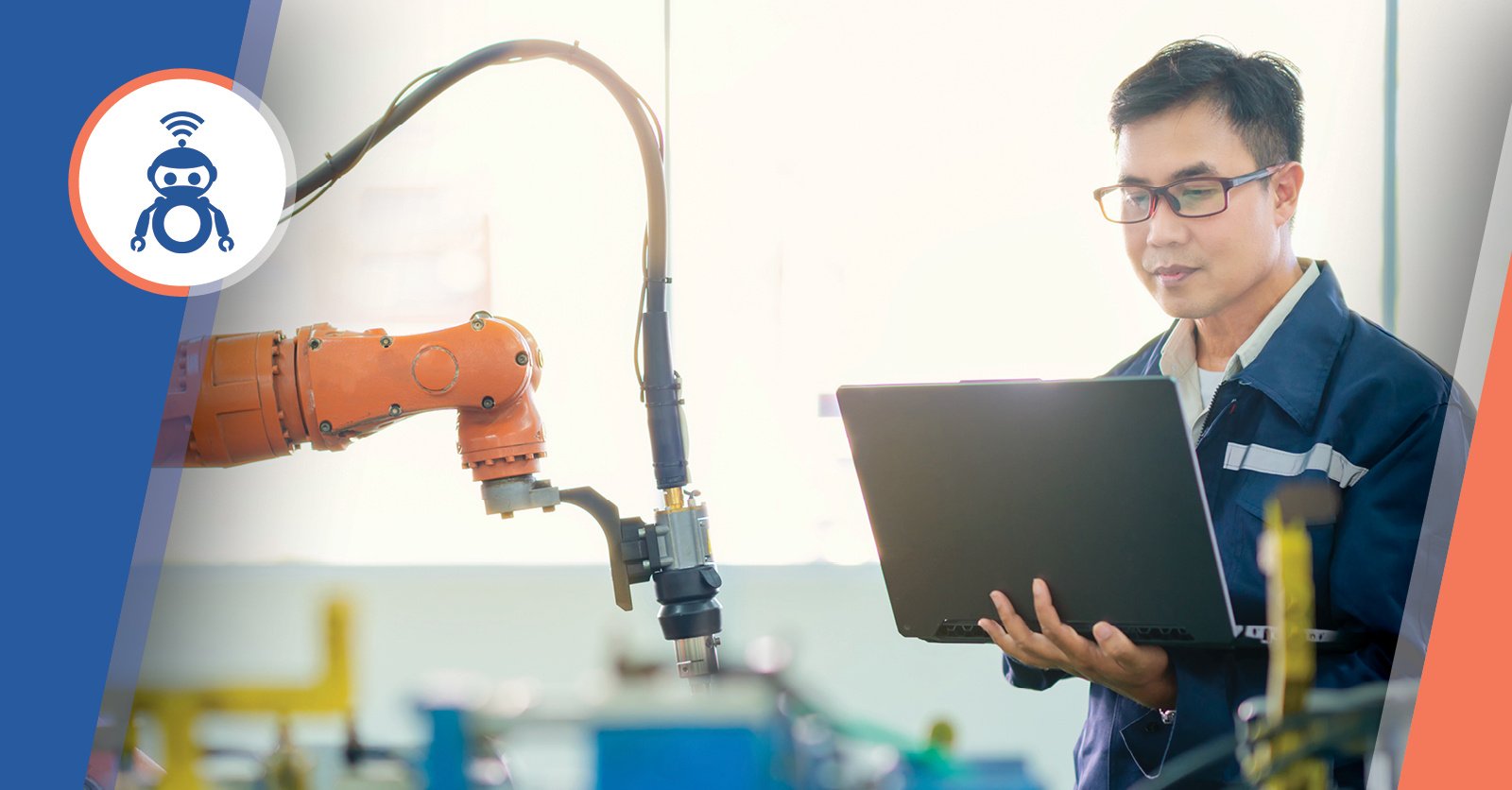Robotic Welding Programmer: An Increasingly Important Career in the Welding Industry

May 31, 2024

As welding robots become more prevalent in the manufacturing industry, the role of robotic welder programmers is becoming increasingly important.
A robotic welder programmer is responsible for programming welding robots to perform various welding tasks, including GMAW (MIG), GTAW (TIG), spot welding, and others.
Whether you are looking to become a robotic welding programmer or to hire one, understanding this role can provide valuable insights into the benefits and opportunities it offers.
Let’s look into the role of welding robot programmers, the benefits of pursuing a career in this field, and how you can get started.
What is a Robotic Welding Programmer?
A robotic welding programmer is responsible for programming welding robots to perform a variety of welding tasks.
They are responsible for setting up the robots, designing fixtures to present parts correctly for efficient welding, and ensuring the welding process operates accurately and consistently. They also troubleshoot any programming-related issues to maintain smooth operations.
What Are the Duties of a Robotic Welding Programmer?
While job descriptions may vary by company, certain roles and responsibilities are fundamental to all welding robot programmers.
Key duties include programming the welding robot for specific jobs, setting up the robot, and ensuring that the welding process runs accurately and consistently. They are also responsible for troubleshooting issues related to programming.
To excel in this role, a robotic welder programmer needs a strong grasp of welding technology. They need to be proficient in programming welding robots, and have a keen eye for detail. They should have excellent problem-solving skills and be able to communicate well.

Essential Skills for Robotic Welder Programmers
- Technical expertise: Must understand welding technology, including various welding processes and how to program welding robots.
- Problem-solving: Needs to be able to troubleshoot and resolve issues that arise during the welding process.
- Attention to detail: Ensures that the welding process is performed with precision and consistency.
- Communication skills: Must be able to communicate with coworkers and supervisors to address any concerns or issues during the welding process.
- Safety awareness: Follows safety protocols to ensure the well-being of themselves and their coworkers.
Differences Between a Robotic Welding Programmer and a Technician
A robotic welding programmer focuses on programming welding robots for different welding tasks. This involves setting up the robot and the fixtures, developing programs for welding jobs, and monitoring the robot to ensure it performs correctly.
A robotic welding technician is responsible for maintaining and repairing the welding robot. This includes troubleshooting, performing routine maintenance, and replacing parts as needed.
While both roles require knowledge of welding techniques and safety protocols, the main difference between the two roles is the focus on either programming or maintaining the welding robot.
Depending on a company's specific needs, it may employ both robotic welder programmers and technicians. Sometimes, one individual might handle both roles.
The Benefits of Becoming a Robotic Welding Programmer
The demand for skilled robotic welder programmers is growing as welding robots, and cobots become more common. This translates into job security in a rapidly advancing industry.
Robotic welding programmers typically earn a high salary, with opportunities for overtime and bonuses.
As a robotic welder programmer, you may work with the latest welding robots and technologies, which can be both exciting and rewarding. This exposure provides ample opportunities for career growth.
Staying current with robotic technologies also means staying ahead of the industry developments and making sure that your skills remain relevant and valuable.
What Is the Salary of a Robotic Welding Programmer?
According to salary data from salary.com, the median annual salary for a robotic welder programmer in the United States as of 2024 is approximately $$88,143. However, this figure can vary widely based on factors such as education, experience, and industry demand.
For instance, individuals with more education and experience may command higher salaries. Those working in high-demand industries or regions may also have the potential for greater earnings.
Salary Range for Robotic Welder Programmers
- High: $79,712
- Low: $100,761
These figures are estimates and may vary. Researching salary data from multiple sources will give a clearer picture of potential earnings for robotic welder programmers.
How to Become a Robotic Welding Programmer
To pursue a career as a robotic welding programmer, you need a combination of education, training, and hands-on experience with welding robots.
Steps to Becoming a Robotic Welding Programmer
- Complete a welding program: Enroll in a welding program at a trade school or community college. These programs provide hands-on training in various welding techniques and coursework in welding technology and safety.
- Obtain relevant certifications: Consider obtaining specialized certifications to boost your prospects. Certifications can demonstrate your expertise in specific areas of welding and may be required by some employers.
- Gain practical experience: Hands-on experience with welding robots is crucial. This can be achieved through internships, co-op programs, or part-time work in related fields.
- Consider a degree: While not always required, a degree in welding technology or a related field can add to your qualifications and make you more competitive in the job market.
- Stay informed about industry trends: The welding field is constantly evolving. Staying updated with the latest technologies and techniques is essential for success. Attend workshops, conferences, and professional development opportunities to stay current.
The Future of Robotic Welding and the Role of Robotic Welding Programmers
Robotic welding is continually advancing, and the role of the robotic welding programmer is likely to evolve alongside it.

Trends Affecting Robotic Welder Programmers
- Adaptive learning and predictive maintenance: As these technologies become more prevalent, robotic welder programmers will need a deeper understanding of machine learning and data analysis.
- Human-robot collaboration: Effective communication and teamwork skills will be essential as human-robot collaboration increases.
- Vision systems and sensors: An understanding of sensor technology will become more important as welding robots incorporate advanced vision systems and sensors.
- Growth of welding cobots: Welding cobots are making it easier for new entrants to join the field. By lowering the knowledge barrier and providing an easy-to-learn solution, welding cobots are helping to address the current shortage of skilled welders and allowing businesses to take advantage of the benefits of robotic welding.
The future of robotic welding looks promising. The role of the robotic welder programmer is expected to remain critical in an industry that continues to face a shortage of skilled welders. With the right education, training, and skills, you can build a rewarding career as a robotic welder programmer.
Will I Lose My Job as a Welder?
It is understandable that welders may be concerned about job security. However, robotics technology should be seen as an opportunity for welders to upskill and take on new roles.
Welders who learn to program welding robots can transition into the role of robotic welder programmer and play an integral part in the implementation and optimization of these systems. They may also advance to supervisory or inspection positions.
Welding robots can relieve welders from repetitive, labor-intensive tasks, allowing them to focus on more complex and engaging work.
Instead of viewing robotics as a threat, welders should see it as an opportunity to broaden their skill set and explore new career paths in the welding industry.
Robotic Welding Programmer Job Description
Robotic welder programmers are essential in the manufacturing sector, improving production efficiency by programming and optimizing robotic welding equipment.
If you are a company looking to hire a robotic welder programmer, here is a job description template for your use. Customize it to fit your company’s specific needs and expectations for the role.
|
Job Description Job Title: About [Company Name]: Who Can Apply: Role Overview:
Job Type: Schedule: How to Apply: |
Consider the Exciting Job of a Robotic Welding Programmer
Whether you’re looking to become a robotic welding programmer or a company hiring for this role, the prospects are exciting.
For individuals, this career offers job security, competitive pay, and the chance to work with advanced technology. Companies can benefit from improved production efficiency and maintaining high-quality standards by bringing in skilled programmers.
As robotic welding technology continues to advance, the role of the welder programmer will only grow in importance, making it an exciting and rewarding career choice.
Robotic welding innovations show no signs of slowing down. Far from being a legacy job, a career as a welder programmer is a surefire way to secure your future in the welding industry!


